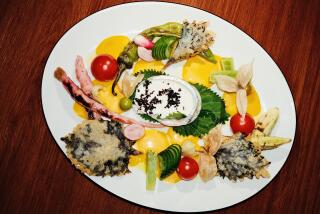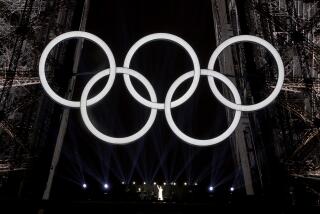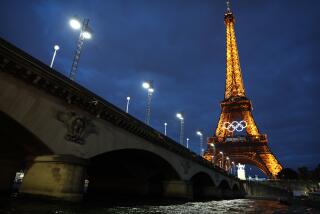Sights and Sounds of Old Paris Live on in Bastille : BASTILLE: Old Paris
PARIS — No other city in the world changes with the swiftness of Paris. Entire neighborhoods disappear, almost overnight it would seem, to emerge the following morning with a brand-new image.
It started in the 1960s when the great central food market, Les Halles, “The Belly of Paris,” according to Emile Zola, was dismantled, replaced by a vast modern (mostly underground) shopping-entertainment complex.
That was soon followed by the flowering of neighboring Plateau Beaubourg, with the sci-fi Centre Pompidou in its center.
Then came the beautification and modernization of the historic Marais quarter, the Picasso museum as its star attraction.
After that, the turn-of-the century Quai d’Orsay railway terminal was refitted as a gallery of modern art.
Meanwhile, high-rises went up, dominating Montparnasse and sections along the Seine. The old slaughterhouse area of La Villette was converted into a garden city, including museums and concert halls.
The Grand Louvre project, which surrounds I. M. Pei’s controversial glass Pei Pyramid, is now open and the Metro arrives there directly. Beyond the Arc de Triomphe, the space-age city of La Defense continues to grow like an out-of-control mushroom.
Latest Face Lift
Next in line for a dramatic transformation is the Bastille quarter. Along the eastern rim of the famous square, the modern Bastille Opera complex has been completed, with the first performance scheduled for Friday night, on Bastille Day, in front of 40 heads of state, including President Bush. Public concerts begin Jan. 1.
New restaurants and cafes have opened on and around the quarter’s square and old ones are being refurbished.
Suddenly, this ramshackle part of the 11th arrondissement, stretching east from Place de la Bastille within a triangle formed by the main arteries of Rue du Faubourg Saint-Antoine, Rue de la Roquette and Avenue Ledru Rollin, is considered chic, already referred to in Paris as “Le nouveau quartier a la mode. “
The Bastille today, however, is still worth a visit. It’s easy to get to, either via Metro or by bus (lines 86, 87 and 91 from the Left Bank, 20 and 29 from Opera).
Historic Monument
The square hardly compares to such landmarks as Place de la Concorde, Place Vendome or Place des Vosges, but the July Column ranks among the city’s more imposing monuments.
On one side, Canal St. Martin, with Port de Plaisance de Paris (the city marina, with pleasure craft tied up), connects the square to the Seine.
In the opposite direction, Boulevard Richard Lenoir serves as the setting for an outdoor market Thursday and Saturday mornings.
Big cafes on the square always have been popular, including La Tour d’Argent, an Art Deco brasserie (no relation to the renowned Left Bank gastronomic outpost of the same name) in a building that is part of the Opera complex.
Just beyond begins the Bastille quarter, down-to-earth on the one hand, high fashion on the other. However, this is still the Paris of half a century or more ago.
Mixed Neighborhood
Once this area was a melting pot of sorts, populated by provincials from central France (mainly from the hills of the Auvergne), Jewish merchants and Chinese craftsmen employed in the furniture trade that had its headquarters on Rue Faubourg Saint-Antoine.
Today, Rue Faubourg Saint-Antoine is still lined with furniture showrooms, but they feature factory-made reproductions rather than handcrafted items.
The quarter is still a center for bar and restaurant fixtures and furnishings. Some furniture repair craftsmen, antique shops and brocantes (second-hand shops) have survived, as have certain Auvergnact bars, charcuteries and restaurants.
New to the neighborhood are the art galleries, some tucked away in pastoral courtyards, along with trendy boutiques and designer shops with such names as Axis, Dolce Vita, French Line, Le Garage and Violence and Passion, owned, operated and patronized by a younger generation.
Traditional Night Spot
The axis of nighttime activity is disreputable Rue de Lappe, a short, narrow street no more than a matter of yards from Place de la Bastille, threading its helter-skelter way between Rue de la Roquette and Rue de Charonne.
Before and after World War II this was one of the toughest streets in Paris. Here were some of the underworld’s favored haunts: Bal Musettes, where apaches danced the java to the sound of accordions, and knives and pistols flashed at the slightest provocation.
Today, what looks like a disaster area--decaying buildings, peeling paint, boarded-up storefronts scrawled with graffiti--is the favored setting for what is referred to as Les branches , the trend-setters.
From midnight to dawn, the top spot is Balajo, a dance hall famed since the 1930s. Singer Edith Piaf danced there, among others. These nights, records spin. Music for dancing ranges from jitterbug, swing, tango and rumba to the latest hits. There are also “tea dances” Monday, Friday and Saturday afternoons to big bands or accordion groups.
A neighbor is La Chapelle des Lombards, where dancing goes far into the night to Latin and West Indian rhythms.
Biggest nights are Monday at Balajo, Tuesday at La Chapelle des Lombards. Favorite late-night eatery is Tapas Nocturne (next to Chapelle des Lombards) serving tapas and Spanish wine by the glass, against a background of flamenco and classic guitar. New to Rue de Lappe is the super-modern Cactus Bleu.
Shopping by Day
By day, Rue de Lappe exudes the calm of a village street in the provinces. Add a few neighborhood bars, an antique shop or two (one deals in intricately carved and inlaid billiards tables of long ago, player pianos, all at astronomic prices).
Charcuterie Tiel has been doing business in the same place for a century, selling regional specialties of the Auvergne. The menu of La Galoche d’Aurillac features Auvergnact dishes.
Galleries are all but hidden in tree-filled, cobblestone courtyards where roses grow. At No. 24, a trio of geese waddle about. It’s country life in the metropolis--all typical of the area, with similar courtyards on neighboring streets.
The quarter turns into a maze of narrow passageways, to be reached on more or less random explorations. Ideally, a walking tour would start at the foot of Rue de la Roquette, with a side journey to the left along Rue Daval and Rue Saint-Sabin, then back across Rue de Lappe to Rue de Charonne.
From there you may pursue a zigzag course between Rues de Charonne and de la Roquette, along passage Thiere, Rue (and passage) Taillandiers, Rue Keller.
Returning to the square on Rue de la Roquette, the July Column stands framed within the lines of centuries-old houses. It all seems so much more real--authentic--than the prettied-up Marais district across the square.
Recalling the Fortress
Later you can descend to the underground passageways of the Metro beneath the square. There, reproductions of old paintings of the original Bastille fortress line the walls. The square was created for Napoleon in 1803, the column added three decades later.
For the sturdy, a 238-step circular stairway winds its way up inside the July Column, affording spectacular views across the city.
On the far side of the square the facade of a building (3 Place de la Bastille) displays a stone plaque with an outline of the original fortress. Unfortunately, the plaque is all but obscured by the awning of a pizza place at street level. Paving stones on the square also form the outline of the fortress.
There are fine views of the square and the July Column from Rue Saint-Antoine. Some typical 17th-Century houses, more or less in their original state, line the street at this end. The same is true of side streets, such as Rue du Petit Musc.
An ideal way to top off a Bastille visit would be with a meal at Bofinger, 5 Rue de la Bastille. It’s the quintessential Paris brasserie .
More to Read
Sign up for The Wild
We’ll help you find the best places to hike, bike and run, as well as the perfect silent spots for meditation and yoga.
You may occasionally receive promotional content from the Los Angeles Times.






